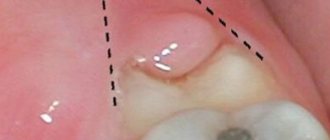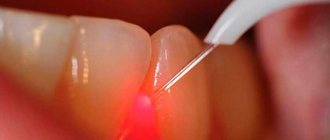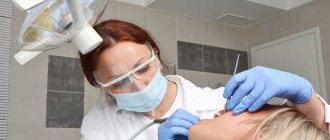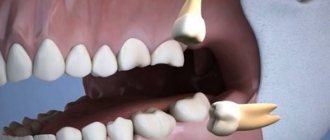Indications for removal of eighth teeth
wisdom teeth
- A pronounced tilt of the figure eight towards the seventh tooth or cheek.
- Hypercementosis (excessive deposition of secondary cement, in which the tooth root thickens and becomes deformed).
- Incomplete eruption of the tooth or its location in the bone (retention).
- Destruction of the crown or roots of the figure eight, as well as neighboring teeth (after injury or caries).
- Granuloma (granulation in the form of cystic sacs with pus located in the periodontium).
- Rotation of the tooth around its axis or horizontal position (dystopia).
- Deformation of the roots (they can bend in every possible way, even twist into a spiral or form an angle of 90°).
- The close location of the roots of the upper eights to the nasal maxillary sinuses.
- In the presence of pericoronitis (an acute inflammatory process in the area of the eruption of the figure eight, accompanied by pain and an increase in ESR in blood tests).
Occurrence of complications
- difficult access;
- frequent retention;
- unpredictable structure;
- features of the location of the mandibular alveolar nerve.
Are common
Painful sensations
Swelling of the tissues of the face and neck
- swelling of the lymph nodes;
- discomfort when swallowing;
- painful sensations during mouth movements, radiating to the ear.
Hematomas
Alveolitis
complications after wisdom teeth removal
- the gums swell and turn red;
- local pain and headache are observed;
- sore throat;
- the temperature rises, muscle aches appear;
- lymph nodes become inflamed, most often the submandibular ones.
- increased persistent temperature;
- poor general health;
- severe migraine-like pain;
- nausea;
- other signs of intoxication of the body.
Increased body temperature
A slight increase in body temperature to 37.5-38 °C also often occurs in the postoperative period. This complication occurs due to a reaction to inflammation. The temperature should completely return to normal within the first day, and if it continues to rise and rise, it means that more serious pathologies have arisen and you need to go to the hospital again.
Bleeding
- rupture of large vessels;
- capillary fragility;
- hypertension.
Damage to the roots of adjacent teeth
Flux
- redness, suppuration and swelling of the gums;
- severe shooting pain;
- temperature increase;
- weakness.
Others
- displacement of the seventh tooth (2 molars);
- mouth rupture; cut gums or cheeks;
- jaw injuries.
Health care
When a wisdom tooth is pulled out and the bleeding does not stop, every day of inaction can cost a person his life. The process of wisdom tooth removal itself is very complex and requires careful attention even when planning the operation. Even if the bleeding is very minor, you should not let things take their course. An infection will develop in the bloody hole, the lesion will fester and bring a lot of problems. At best, a person will get away with a decrease in immunity and an exacerbation of all his chronic diseases. At worst, sepsis may occur, a dangerous condition that threatens life.
There is no need to hesitate to call an ambulance, since bleeding is always a good reason to call an ambulance. It is possible that the patient will be immediately admitted to a hospital, which would be inappropriate to refuse.
Specialists usually take the following measures to prevent blood loss:
- Electrocoagulation. Bleeding vessels are cauterized (soldered) using a needle electrode. This is a very quick procedure that is tolerated well by all patients. But usually it only helps those who, through negligence, opened the hole and provoked bleeding. For people with hypertension and poor coagulation, a simple electrocoagulation procedure will not help.
- Gum suturing. This method is used when a blood clot has been washed away and the patient is suffering from dry socket. In such cases, the gums do not heal without medical intervention. When sutures are placed, the patient should strictly follow safety precautions. You will need to wash and treat the sutures with an antiseptic, as well as regularly visit the dentist to monitor the healing process.
- Drug treatment. This simple and safe method of therapy is used in situations where the patient has poor blood clotting. The doctor prescribes a course of treatment with antibiotics and drugs that increase clotting. Regular visits to the doctor will be required for monitoring, since the healing process of the gums can be unpredictable due to the fact that the natural healing functions are impaired.
Gum stitching is an effective way to stop bleeding
What to look for
The most serious consequences that can occur after wisdom tooth removal:
- Alveolitis. This is an acute inflammatory process. It begins in the tooth socket and gradually spreads to other gum tissues. The most common reason for the development of alveolitis is improper care after removal.
- Paresthesia. Develops when the root of the jaw nerve is damaged or irritated. Manifested by a feeling of tingling, burning, numbness.
To avoid developing serious problems, monitor your oral health. The first symptoms are not difficult to replace:
- Bleeding from the socket. This is not always a sign of complications. Immediately after removal this is a normal reaction of the body. In the first minutes after tooth extraction, bleeding will be slightly heavier. The dentist treats the wound with antiseptics and packs it. After some time, the bleeding stops. Slight bleeding persists for 2-3 hours. This is also normal. You should pay attention to bleeding if it is profuse and begins several hours after removal. In this case, contact a specialist immediately.
- Swelling and pain. This is also a natural reaction. Pain occurs as the anesthetic wears off. Normally it lasts 2-3 days. At the same time, the gums swell slightly. You should sound the alarm if the swelling transfers to the cheek. In complex cases, the tumor can be very large. Severe swelling is one of the symptoms of alveolitis.
- Fever. On the first day after removal, the temperature rises to 37 degrees. Such an increase is within normal limits, especially if the operation was complicated. When the temperature lasts more than a day or rises strongly, this is a symptom of inflammation. To prevent the inflammatory process from spreading to neighboring tissues, visit a dental clinic.
- Suppuration. The inflammatory process, accompanied by suppuration, has pronounced symptoms. Suppuration is indicated by a putrid odor from the mouth and an unpleasant taste. When examining the tooth socket, you may notice gray plaque or white purulent contents. In this case, you need to go to the dentist immediately.
- Headache. Immediately after wisdom tooth removal, headache is normal. It is caused by stress and anesthetic drugs. If the headache is severe and is accompanied by fever, swollen lymph nodes, and weakness, we recommend visiting a doctor.
Final provisions
When a doctor diagnoses pericoronitis, it means that the gums around the erupting teeth - permanent or baby - have become inflamed, and the tooth is probably not growing properly. The abnormality creates a pocket called a hood between the new tooth and the soft tissue. The cavity quickly fills with a substrate consisting of plaque and bacteria, and decay begins. The main symptom is pain at the site of the growing tooth; in addition, other signs are present.
Pericoronitis is treated by removing the inflamed soft tissue (hood), or extracting the tooth (in extreme cases). Home methods, rinses, lotions will not help, they can only do harm if you rely on them completely and do not visit the hospital.
Treatment of pericoronitis can be quick - in the early stages, and long and painful - in advanced stages. A person can prevent the development of pathology while complying with hygiene standards. And it is worth remembering that modern dentistry is a very rapidly developing branch of medicine. Trust the professionals to help you maintain your health.
Restoration of tooth enamel, price, drugs
Mistakes and complications in the treatment of dental pulpitis
Dental treatment without pain in Moscow
Treatment of pericoronitis of the wisdom tooth in the lower jaw
Retreatment of tooth canals before prosthetics, with granuloma, cyst and aching pain
Treat or remove wisdom tooth pulpitis
Repeated endodontic treatment of tooth canals for pulp inflammation
Why complications arise
Removal of a wisdom tooth performed by an experienced surgeon in a healthy person rarely leads to complications. There may be some discomfort, but it goes away quickly. Serious consequences can occur for various reasons. The most common is improper care. Provoking factors may be:
- Dental diseases. Caries on neighboring teeth, inflammation of the mucous membrane and other diseases can lead to the transfer of pathogenic microflora into the socket. As a result, the wound becomes inflamed.
- Reduced immunity. Removing a wisdom tooth is a surgical procedure. When immunity decreases, recovery takes longer.
- Systemic diseases. Hypertension, blood clotting problems and other cardiovascular diseases can lead to various problems, such as bleeding from the socket.
Medical errors can also lead to complications after wisdom tooth removal:
- Violation of operation regulations.
- Violation of antiseptic rules.
- Not completely removed root, etc.
Removing a wisdom tooth is a complex operation, so you should not trust your health to an inexperienced dentist. Our clinic employs highly qualified surgeons. Therefore, you do not have to worry that serious pathologies will develop due to medical errors.
Treatment of acute pericoronitis
Treatment of the disease is usually carried out in two ways: removing the hood or removing the tooth. Adherents of unconventional methods of treatment and grandmother's recipes should be reminded that not a single dental disease can be cured using traditional methods. The use of decoctions, tinctures and other methods can only alleviate the symptoms, but without consulting a specialist, it is very easy to let the disease progress until a serious health situation develops. Therefore, going to the clinic is mandatory.
How to care for a hole
Immediately after the procedure, you can apply ice to your cheek to relieve pain and swelling. For severe pain, you can take an analgesic. During the healing period, follow these simple rules:
- Do not rinse your mouth with any solutions unless prescribed by your dentist.
- The tooth socket should not be touched with hands or a toothbrush.
- Avoid physical activity and do not go to the sauna until the wound is completely healed.
- Take medications prescribed by a specialist.
- Do not drink alcohol, as it can cause bleeding.
The surgeon will give you detailed recommendations after the operation. If you notice symptoms of complications, contact your dentist immediately. At our clinic, please contact the doctor on duty for help.
Complications after wisdom tooth removal can occur almost immediately after the operation. Some of them are natural, since removal is a complex surgical procedure, “eights” are located in hard-to-reach places, and they have large roots. But sometimes complications can make themselves felt within six months, and they provoke diseases of the gums, adjacent teeth, bones and even joints. To prevent such problems, you need to know the first signs of pathology and urgently contact an experienced dentist.
Why doesn't the bleeding stop?
It happens that immediately after surgery the bleeding stops safely with normal clot formation, but after some time (several hours or even days) it suddenly starts bleeding again. But most often in complicated situations, bleeding begins immediately after surgery and continues without pause for a long time. It is necessary to find out the exact causes of this condition.
High blood pressure
It doesn’t take many reasons for a hypertensive patient to get a complication in the form of long, debilitating bleeding from the socket. Typically, a person who suffers from elevated numbers on a tonometer alerts the dental surgeon about this and receives a special approach. But sometimes this does not prevent complications. Hypertensive patients often spend a couple more hours in the dentist’s office after surgery to be monitored by doctors.
It happens that the blood stops within the walls of the dentistry, but at home it starts flowing again. Any exciting thought or memory of an operation can be a provocation: even a slight stress can provoke a rise in pressure, and as a result, re-opening bleeding from a fresh wound. Therefore, before removing a wisdom tooth, a person with hypertension also needs to receive instructions from a therapist.
Poor blood clotting
This factor is very dangerous and requires special precautions, both on the part of the patient and the doctor. If the patient has problems with blood clotting, it is very risky to treat diseased teeth. It is necessary to receive treatment in a timely manner so that an emergency situation does not arise when the patient is literally on the verge of life and death.
The problem is that it is not always possible to “detect” such a blood condition in a patient. Sometimes it occurs immediately after surgery. Often women suffer from poor clotting during menstruation. But if the patient is aware of the problem, and wisdom tooth removal is not urgent, then it is advisable to conduct a number of special studies before the procedure.
Negligent attitude towards recommendations
The dentist always informs the patient in detail about the rehabilitation period after surgery, even handing out a special sheet with instructions. A large number of recommendations are related specifically to stopping bleeding. For example, after surgery you should not spit, much less rinse your mouth - a valuable clot may fall out. Solid and hot food, drinking, and physical activity are prohibited. Patients are not always conscientious about their own health and hope for “maybe.” Any violation of the rules leads to renewed bleeding from the hole.
Inflammation of the socket
Upon completion of the operation, the dentist treats the hole with several types of antiseptics. Even despite this measure, the socket can become inflamed, become a source of infection, and as a result, the gums bleed profusely. Self-treatment in this situation is inappropriate and can only worsen the problem. If the temperature has risen, the cheek in the area of the wisdom tooth is swollen, and blood continues to flow, you must immediately consult a doctor.
Purulent hole
If the figure eight is to be removed, it is recommended to first examine the dental system using X-rays to exclude pathologies and complications. Dentists are very upset by the fact that many patients endure pain until the last minute and do not go to a medical facility. And when the operation is scheduled, an infection is already raging in the body, which has spread from the diseased tooth.
The affected area may contain cysts, phlegmons and granulomas, which, due to the urgency of the operation due to the fault of the patient himself, are not always detected by the doctor. These purulent formations impair blood clotting in the area of inflammation, and when a wisdom tooth is removed, the patient loses a lot of blood during and after the operation.
Traumatic surgery
Patients can be as much to blame for complications as the dentists themselves can be incompetent and careless. During the operation, tissues and vessels will have to be torn in any case, but how much the gums will be torn largely depends on the surgeon. If the wisdom tooth is removed carelessly, the soft tissues will suffer and cause heavy bleeding, severe pain and even suppuration of the gums.
If large branches of the arteries are damaged, severe bleeding comes from the depths of the hole. The patient may not immediately notice the extensive damage that occurred during the operation due to the effect of the anesthetic. As soon as the action of the injection is completed, the sensations will return, the vessels will dilate, and blood will begin to flow out of the hole.
Various types of complications prevent a blood clot from forming
Main consequences after wisdom tooth removal
- Dry socket is a consequence that occurs due to the doctor using anesthetics and vasoconstrictor drugs at the same time. As a result, the arteries become spasmed, and a blood “sac” (clot), which is required for natural wound healing, does not form in the socket. .
- Pain in the socket area is a common condition that can last up to five days. If the pain does not go away, and after five days it becomes more active, you should urgently consult a doctor.
- alveolitis - inflammation that occurs due to the presence of infection in the oral cavity, tooth fragments;
- pointed edges of the alveoli are a consequence of unprofessional removal of the “eight”;
- osteomyelitis of the socket is a consequence of poor wound treatment in the first hours and days after surgery;
- exposure of the alveolar zone - an injury against which part of the bone is exposed;
- neuropathy of the alveolar nerve - when, during the elimination of the “8”, the nerves of the lower jaw were affected.
- The formation of abscesses and phlegmon is a common phenomenon that develops as a result of infection during surgery or wound treatment. An acute inflammatory process develops in the tissues, and a sac with purulent contents forms. The patient feels severe pain, the tissues in the surgical area become denser, the pain becomes throbbing and acute, the body temperature rises, the head feels dizzy, and the cheek puffs out.
Frequent complications after removal of a wisdom tooth in the upper jaw: alveolitis (inflammation of the socket), hematomas (when the doctor damages a vessel), bleeding (this area is abundantly supplied with blood), damage to the bottom of the sinus. jaws, swelling and inflammation of tissues.
Common complications after removal of a wisdom tooth in the lower jaw: gumboil, damage to adjacent nerve endings, bleeding, stomatitis, cysts, etc.
Signs of complications after wisdom tooth removal:
- the wisdom tooth socket becomes brown, sometimes acquiring a bluish tint;
- increased pain;
- swelling;
- increased body temperature;
- heavy bleeding;
- dry socket;
- weakness;
- weak appetite;
- pain when swallowing food and drinks;
- difficulties opening and closing the mouth, etc.
In case of all the complications listed above, you must definitely contact an experienced, trusted dentist. The doctor will conduct an examination, determine the problem and prescribe adequate treatment.
Perforation of the floor of the maxillary sinus
Perforation of the floor of the maxillary sinus can occur when removing upper molars, less commonly premolars. Contributing factors: • anatomical features of the structure of the upper jaw - low position of the sinus bottom and features of the relative position of the roots of the teeth with the sinus; • infectious and inflammatory processes (periodontitis, osteomyelitis), cysts, tumors. They lead to resorption of the bone plate between the sinus and the apexes of the roots of the teeth, up to its complete absence; • rough removal of teeth and curettage of pathological tissues from the apical periodontium.
Clinic for perforation of the maxillary sinus floor
The clinical picture of perforation of the maxillary sinus floor is quite specific. A characteristic symptom is the appearance of bloody discharge from the nose on the side of the perforation. The patient complains of air passing through the tooth socket and a feeling of pressure.
Diagnosis of perforation of the maxillary sinus floor
Diagnosis of perforation of the floor of the maxillary sinus is quite simple. When the bottom of the maxillary sinus is perforated, a connection between the oral cavity and the nasal cavity occurs. Therefore, when the pressure in the nasal cavity and sinus increases during vigorous exhalation, air can penetrate into the alveolus of the extracted tooth, causing foaming of the blood present there. If you invite the patient to pinch the external nose and exhale vigorously through the nose, the appearance of bloody foam in the alveolus of the extracted tooth will appear even more clearly. In this case, you can hear the whistling sound of a stream of air passing into the mouth through the alveoli (nasal test). If you ask the patient to increase the pressure in the oral cavity (inflate the cheeks), you can hear the whistling sound of a stream of air passing from the oral cavity into the maxillary sinus through the alveolus of the extracted tooth, and from the sinus into the nasal cavity through a natural opening - hiatus maxillaris (oronasal test). A characteristic symptom is the appearance of bloody discharge from the nose on the side of the perforation.
Prevention of perforation of the maxillary sinus floor
Prevention of perforation of the floor of the maxillary sinus comes down primarily to identifying the presence of risk factors in the patient before removing the upper molars based on X-ray data and medical history. Removal of pathological tissue in the area of the apex of the upper molars should be carried out carefully, and if there are risk factors, the procedure should be abandoned altogether.
Treatment of perforation of the maxillary sinus floor
Treatment of perforation of the bottom of the maxillary sinus consists of creating conditions for the formation and preservation of a blood clot in the alveolus of the extracted tooth. After replacing the blood clot with granulation, osteoid, and then mature bone tissue, there will be a reliable separation of the maxillary sinus from the oral cavity. This is achieved in the following ways. 1. Bringing the gum edges together with sutures. Thus, the entrance to the hole from the oral cavity is blocked. 2. Laying of the mucoperiosteal flap in the area of the vault of the vestibule of the mouth, bringing it down until it comes into contact with the palatal edge of the gums
Before suturing, the walls of the alveoli are carefully scraped out with a sharp curette, which causes bleeding and promotes the formation of a blood clot, opening the way for the release of osteoblast precursors involved in reparative osteogenesis. Any osteotropic biological product can be injected into the alveolus.
When is the wound guaranteed to heal after removal of the “8” (wisdom tooth)
The resulting hole “heals” and heals within two to three weeks. The healing process begins with the formation of a blood clot, and epithelium forms on the surface of the wound. After complete healing, weight bearing on the operated area is allowed.
If the wisdom tooth was removed by a surgeon without complications, the wound will heal in about 15-18 days.
If certain problems arose (for example, the tooth had several roots), this period may increase to 25 days.
Only a dentist can evaluate the process of healthy or pathological wound healing. Ideally, it is recommended to visit a specialist’s office 5-7 days after removal of the “eight” to avoid complications.
How to remove a tooth
There are two extraction methods used in dentistry: simple and complex. Their choice depends on which teeth are being removed - premolars and molars with tangled branched roots are removed using a complex method. It is very difficult to pull out such elements entirely due to the fact that the tooth socket is penetrated by retaining ligaments and alveolar processes. Errors during the procedure or insufficient experience of the specialist lead to serious complications. Therefore, even despite the acute condition, always find out in advance where you can have a tooth removed from a good doctor with positive recommendations.
Factors complicating the operation:
- complete destruction of the coronal part;
- high fragility;
- acute inflammatory diseases;
- Unerupted or misaligned wisdom teeth.
The technology of the procedure depends on which teeth are removed. In some cases, tissue incision and suturing are performed.
Wisdom tooth removal
Wisdom teeth are considered full-fledged elements of the oral cavity. They are involved in chewing food (if they are located above each other and have contact), and can act as a support for bridges and removable dentures in the future. There are specific indications for extraction in their case. For this reason, the decision about whether wisdom teeth need to be removed is made only by the attending physician.
The most common problem with eighth teeth is their growth. Only some teeth form and grow completely without complications, but often these processes are accompanied by a number of difficulties:
- semi-retinated or impacted elements that have formed in the bone tissue, but have not erupted or only partially erupted. Their position can be vertical, horizontal, or with their roots outward. Because of this, neighboring elements suffer, constant pain appears;
- violation of position (dystopia). Since wisdom teeth erupt without predecessors (baby teeth), and the jaw bone is already formed and does not develop, the position of the elements is often incorrect. They injure the mucous membrane, overlap other crowns, and put pressure on neighbors. This leads to inflammation. The doctor will determine whether the position can be restored with orthodontic treatment or whether it is better to remove the wisdom tooth;
- appearance of a gingival hood. When slowly cutting through the mucosa, an area is formed in which bacteria and food debris accumulate, which are difficult to clean. This leads to acute inflammation, which can provoke the appearance of pus;
- destruction, caries. Elements may appear immediately underdeveloped with carious lesions.
The doctor determines whether wisdom teeth should be removed or not based on complaints and the clinical picture. Problems with even one or two teeth interfere with the normal functioning of the entire dental system. Pain appears when opening the mouth and chewing. The bite and position of the incisors may even change.
How a wisdom tooth is removed depends, as in the case of permanent elements, on the condition of the dental system. In the absence of contraindications, manipulation is carried out with ordinary forceps.
Causes of prolonged bleeding
Experts identify many reasons that can lead to resumption of bleeding. Primary can begin due to vascular injury received during the procedure, hypertension, sudden surges in pressure, and even due to severe stress.
Also among the provoking factors are the use of Aspirin and other blood thinning drugs, hormonal imbalance or the usual increase in estrogen levels in women. Pathology can also develop if the rules of oral care are not followed, rinsing too vigorously, accidentally injuring the gums with the tongue or foreign objects, or eating too hard or hot food.
Another reason for close monitoring of the patient’s condition after surgery is tooth extraction due to existing gumboil or cyst. Tissues in which there is inflammation usually have greatly dilated blood vessels. You can also encounter unpleasant consequences with blood diseases, for example, with anemia or hemophilia, with diabetes mellitus, atherosclerosis, etc. To reduce the risk of bleeding in the first few days after surgery and before it, you do not need to drink alcoholic beverages.
Root removal
How is the root of a tooth removed if the tooth is completely destroyed? Despite this situation, extraction is not always recommended. If, after diagnosis, the doctor determines that the root can be used for an inlay, then the tooth is restored with a crown. But if there is pain, an unpleasant smell and taste, or swelling has developed, then dental care is required urgently. In this case, the question of whether to remove the roots of the teeth is decided in favor of the operation, since the neglected condition can also lead to the loss of neighboring elements.
Regardless of the chosen technique, pain relief and X-ray control are required after removal. This allows you to make sure that there are no root fragments in the cavity, since it is often loose and can crumble under slight pressure from the forceps.
Recommendations after removal
Regardless of which tooth you removed or just its root, you must follow the rules of the rehabilitation period. Then healing takes place quickly and without complications.
- Do not eat for 2-3 hours after surgery.
- Eliminate hot and solid foods from your diet for 7 days.
- Carefully walk around the socket when brushing your teeth.
- Do not pick out the blood clot and try not to disturb the hole with your tongue until it is completely healed.
- Don't rinse your mouth.
The Vimontal Clinic carries out operations of any complexity using advanced equipment. This allows you to provide assistance with maximum comfort and safety.
Doctors providing this service
Modern surgical dentistry makes it possible to avoid tooth extraction in most cases, but tooth extraction is still sometimes necessary.
An operation to remove a tooth should be performed only as a last resort, when other methods to save the tooth are no longer possible or when the tooth may cause other, more serious complications.
Indications for tooth extraction
A fairly common indication for tooth extraction is the need to sanitation the oral cavity in the presence of chronic periodontitis in the acute stage, when it is impossible to eliminate the inflammatory focus at the apex of the tooth.
In some cases, tooth extraction is performed to avoid more serious complications. For example, if you have teeth that can cause a cyst, inflammation or neuritis of the trigeminal nerve. If a tooth constantly injures the tongue or the mucous membrane of the cheek, and also interferes with a normal bite, it is also better to remove such a tooth. Multi-rooted teeth, which are the cause of odontogenic osteomyelitis, are removed. When fitting a removable denture, sometimes it becomes necessary to remove teeth, but there must be strict indications for this.
Surgical operations to remove a tooth are performed under effective anesthesia, taking into account all contraindications.
Teeth are removed when they are severely damaged by caries, affected by advanced periodontal disease (“sick gums”), have been broken so that they can no longer be restored, are incorrectly positioned in the mouth (for example, an embedded wisdom tooth), or in preparation for orthodontic treatment.
Before starting tooth extraction, the dentist examines the oral cavity, takes x-rays of diseased teeth, and evaluates their condition.
After a tooth is removed, the teeth adjacent to it begin to gradually shift, sometimes quite significantly, and this can greatly affect the general condition of the teeth. Removing even a single tooth can create serious chewing problems. To avoid these complications, the dentist will recommend replacing the extracted tooth with an artificial one.
Considering all the advances in operative surgery today, most patients prefer to replace the existing dentition defect by placing a dental implant (advantages of using dental implants), dental bridges or removable partial dentures.
Wisdom teeth removal
The removal of wisdom teeth is due to slightly different reasons. Naturally, the above reasons for tooth removal also apply to the removal of wisdom teeth, however, this case has its own characteristics.
Problems with wisdom teeth often arise as soon as they erupt. They erupt at the age of 18-25 years (sometimes much later), when the dentition is formed by 28 teeth, which leads to incorrect placement of wisdom teeth in the dentition (the lower wisdom teeth are more often displaced), immersion (incomplete eruption with a tilt in the vertical, horizontal, distal or medial direction). In addition, misaligned wisdom teeth can cause damage to adjacent teeth, putting pressure on them and causing root damage and resorption, as well as displacement and malocclusion.
There are no dental rules determining the most acceptable age for wisdom tooth removal. However, practice shows that the sooner you get rid of these teeth, the fewer complications you can expect from them in the future.
If the wisdom tooth is in the wrong position or has not fully erupted, this leads to pericoronitis (inflammation of the tissues surrounding the tooth), because Part of the tooth is located under the gum and food debris accumulates in the gum pocket, which is an excellent breeding ground for various microorganisms. Wisdom teeth are often affected by caries, because... Between it and the second molar, food debris also accumulates and plaque forms due to the fact that this space is difficult to clean with a toothbrush. In this case, caries affects not only the wisdom tooth, but also the second molar adjacent to it.
- refrain from eating for 2-3 hours after removal;
- do not drink alcohol or take a sauna on the day of surgery;
- do not touch the hole with your tongue or any objects;
- do not eat hot food;
- do not rinse your mouth.
Consequences and complications
- The development of inflammation in the maxillary sinus and its spread to the adjacent bone tissue.
- Involvement of other sinuses in inflammation: frontal, ethmoid, sphenoid.
- Formation of an abscess or cellulitis.
- Loss of teeth located in the perforation area.
- Development of osteomyelitis and meningitis.
In order not to suffer from the consequences and not to expose yourself to danger, choose dentistry and your doctor correctly. With sufficient professionalism of the doctor, all operations on tooth extraction and implantation are carried out easily and safely.










